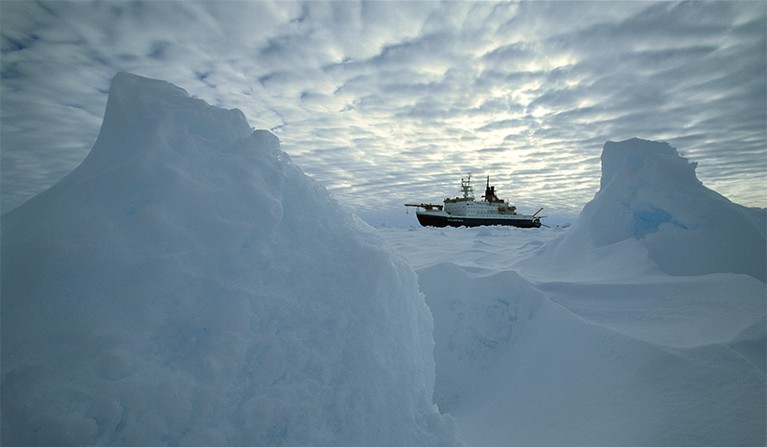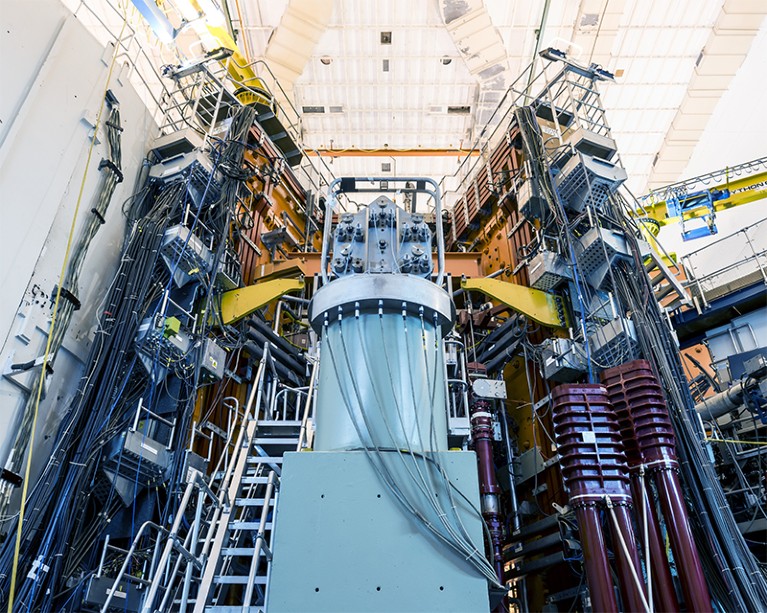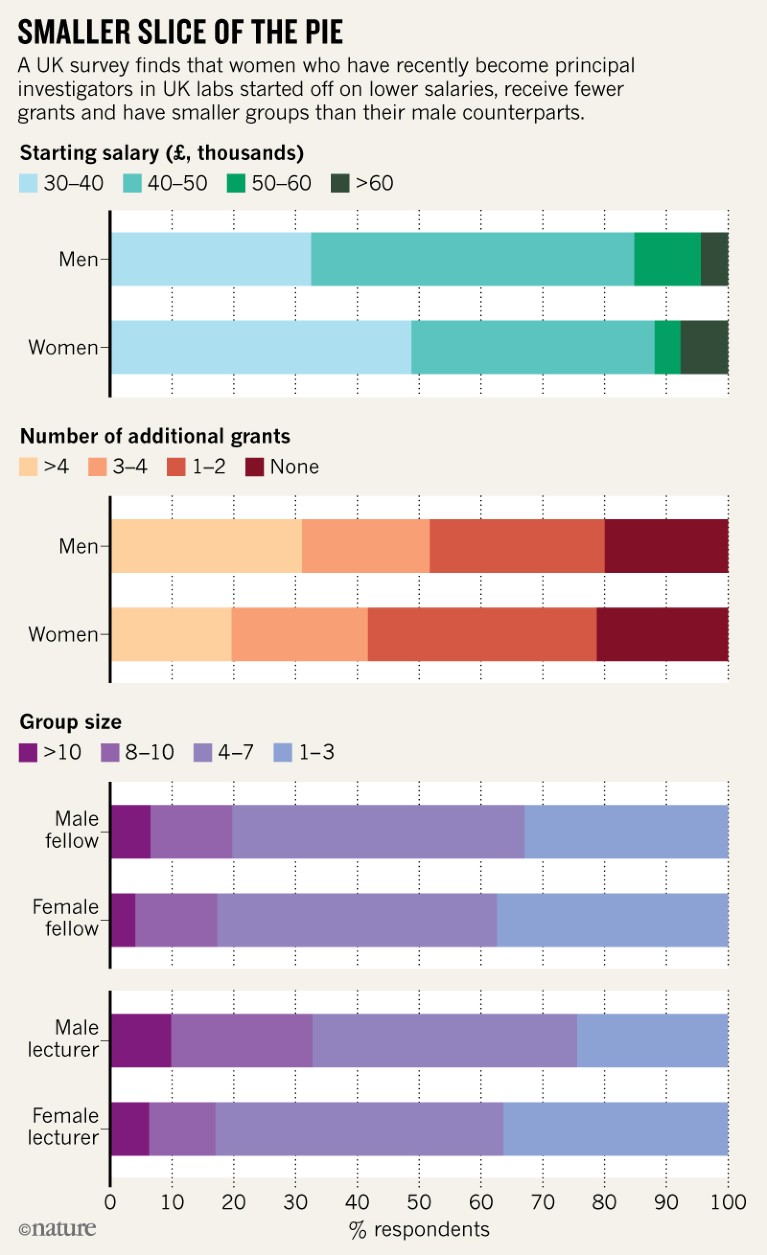EVENTS
Thick ice thwarts Antarctic mission Thick sea ice has halted plans to explore a unique polar ecosystem in the Southern Ocean that was revealed when a giant iceberg calved from the Antarctic Peninsula in 2017. An international science team on board the German research ice-breaker RV Polarstern (pictured) had set off for the Larsen C ice shelf from Chile on 18 February. The ship navigated the Antarctic waters at the tip of the peninsula, but encountered dense sea ice to the east, in the Weddell Sea. After a week of fruitless attempts to find a route, Polarstern’s captain abandoned plans made earlier this month to sail farther south towards Larsen C. The research teams agreed to do alternative fieldwork in more-accessible regions. It is the third time that an expedition has failed to reach the calving site. Towering sea ice stopped a British Antarctic Survey team from getting there in February last year. A South African vessel retrieved ice samples about 200 kilometres north of the site before turning back in January.

German research icebreaker Polarstern has struggled to navigate thick sea ice near Antarctica.Credit: Ingo Arndt/Minden/Getty
Tougher laws Nearly 400 Australian scientists have signed a letter protesting against a steep rise in land clearing over the past decade. They have called on national and state governments to legislate to protect native vegetation. The letter describes Australia as a ‘global deforestation hotspot’, following the relaxation of laws protecting native vegetation in New South Wales and Queensland in the past ten years. Land clearing has been linked to increases in the number of threatened species, the letter states, while also contributing to climate change, which heightens the risk of bush fires and drought.
CLIMATE CHANGE
Sea-level plan New York City mayor Bill de Blasio wants to protect Manhattan from climate change by expanding the island’s southern shore to keep rising seas at bay. The US$10-billion plan would extend Manhattan Island by up to 150 metres into the East River, using materials such as sand or concrete rubble to build an elevated landscape. Lower Manhattan is a global financial centre that flooded during Hurricane Sandy in 2012. The project would help to protect the area from what could become daily floods on some streets by 2100, city officials said during a 14 March press conference. New York City will seek federal and state funds for the project. The plan would build on an existing $500-million effort to fortify the current shoreline, which is itself an extension of the island constructed using sand and landfill materials.
Resolution dropped The United Nations Environment Assembly, which met last week in Nairobi, did not adopt a resolution calling for an international assessment of geoengineering technologies that could be used to cool the planet. The resolution, proposed by Switzerland and ten other countries, would have required the UN Environment Programme to prepare a report by 2020 on the science and technology behind options such as injecting aerosols into the stratosphere to reflect sunlight away from Earth. The report would also have analysed the governance of such technology and its potential wide-scale use. Switzerland withdrew the resolution on 13 March in the face of opposition from countries including the United States and Saudi Arabia. Opponents said that the Intergovernmental Panel on Climate Change is already addressing the issue.
PUBLISHING
Open-access talks Norway has decided not to renew its contract with Dutch publishing giant Elsevier after disagreeing on the cost of a ‘read-and-publish’ deal, which combines the cost of reading subscription journals with open-access publishing fees for researchers. On 12 March, Norway became the fifth country or university system in eight months to walk away from negotiations with the publisher over the cost of such deals, which many countries and institutes are pushing for in a bid to make more of the scientific literature free to read. Norway’s decision comes two weeks after the University of California — the United States’ largest public university system — declared that it could not come to an agreement with Elsevier and cancelled its subscription. National library consortia in Hungary, Sweden and Germany also did not renew deals with the publisher. On 15 March, US publisher Wiley announced that it had struck a read-and-publish deal with Norwegian negotiators representing 33 institutions.
RESEARCH
Nuclear-fusion lab The UK government will step in to pay for a European Union-funded nuclear-fusion laboratory near Oxford after 29 March, if a European cash source cannot be secured in the next eight days. The Joint European Torus (JET) laboratory (pictured) is testing fuel technologies for the world’s largest nuclear-fusion experiment, ITER, being built in France. It currently has only a short-term contract with the European Commission, and this runs out on 28 March, the day before Britain is scheduled to leave the EU. Until now, JET has received around 88% of its funding from EU sources, and the remainder from the United Kingdom. Negotiations with the EU to agree on a funding contract that would last until the end of 2020 are ongoing, but have stalled in part because of uncertainty caused by Brexit. On 13 March, UK Chancellor of the Exchequer Philip Hammond promised up to £60 million (US$80 million) for JET, to cover its running costs in 2019–20, should no new agreement be reached in time.

The Joint European Torus near Oxford, UK, is mostly funded by the European Union.Credit: Alastair Philip Wiper/SPL
Mars rumbles NASA’s Mars InSight lander has measured low-frequency rumbles, known as infrasound, produced by weather systems passing above the spacecraft. It is the first time that infrasound has been detected on Mars, Philippe Lognonné of the Paris Institute of Earth Physics told the Lunar and Planetary Science Conference in The Woodlands, Texas, on 18 March. InSight landed last November in a region known as Elysium Planitia, and placed a seismometer on the surface. This picked up the infrasound rumbling, but has yet to detect ground shaking from a marsquake, which scientists hope will tell them about the red planet’s interior.
Eye therapy A Japanese committee has provisionally approved the use of reprogrammed stem cells to treat diseased or damaged corneas. Researchers are now waiting for final approval from the health ministry to use the treatment in people with corneal blindness, which affects millions around the world. A team led by ophthalmologist Kohji Nishida at Osaka University plans to transplant sheets of tissue made from induced pluripotent stem cells onto damaged corneas. The sheets are created by reprogramming cells from a donor into an embryonic-like state that can then transform into other tissue, such as corneal cells. Animal studies have shown that this can save or restore vision.
FUNDING
Science spending US President Donald Trump has proposed steep cuts at the National Science Foundation (NSF) in his 2020 budget request, released on 18 March. The biggest cut would hit funding for polar research, mathematics and physical sciences. Funding for the Office of Polar Programs would shrink by nearly 20%, to US$403.4 million, from 2018 spending levels. The NSF is still working out its exact 2019 spending levels for various programmes and directorates, which it plans to submit to Congress for approval by 1 April. Trump has proposed an estimated 17% cut for the mathematical and physical sciences directorate from 2018 levels, to $1.3 billion. The more detailed budget request follows a bare-bones funding proposal that the president released on 11 March. It’s unclear whether lawmakers in Congress will go along with Trump’s budget request, because they ignored his proposed cuts to science agencies in 2017 and 2018.
TREND WATCH
Women who have recently started their own laboratories face more obstacles than their male peers when growing a research group from scratch, according to an analysis. The survey of 365 principal investigators, all of whom started their research groups in the United Kingdom between 2012 and 2018, found that many male and female scientists lacked adequate support — but women faced extra barriers. The study, which was published on the preprint server bioRxiv (S. E. Acton et al. Preprint at bioRxiv https://doi.org/10.1101/571935; 2019) on 10 March, found a pay gap of about £3,000–5,000 (US$4,000–6,600) between men and women. In many cases, this was because women started at a lower pay grade. Women also tended to receive fewer grants, had fewer PhD students and postdocs working in their teams, and had less access to lab space. Once initial grants run out, junior lab heads will be competing against each other for the next round of funding, say the authors, so starting off with fewer resources puts female investigators at a disadvantage when progressing in their career.

Source: S. E. Acton et al. Preprint at bioRxiv https://doi.org/10.1101/571935 (2019).





